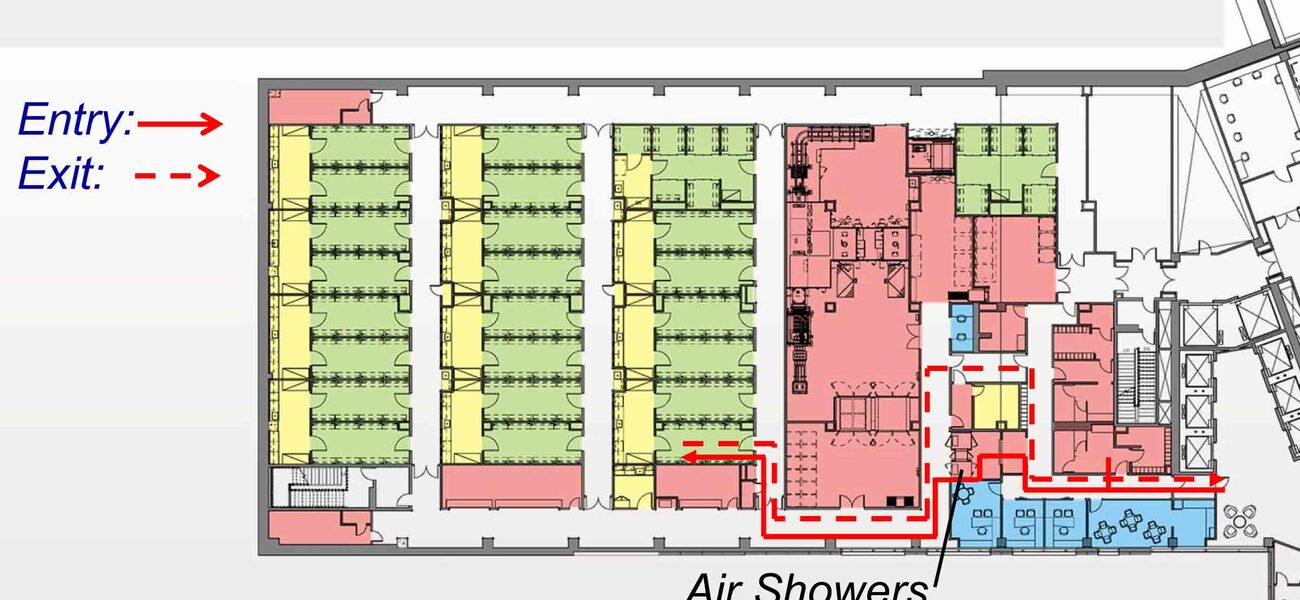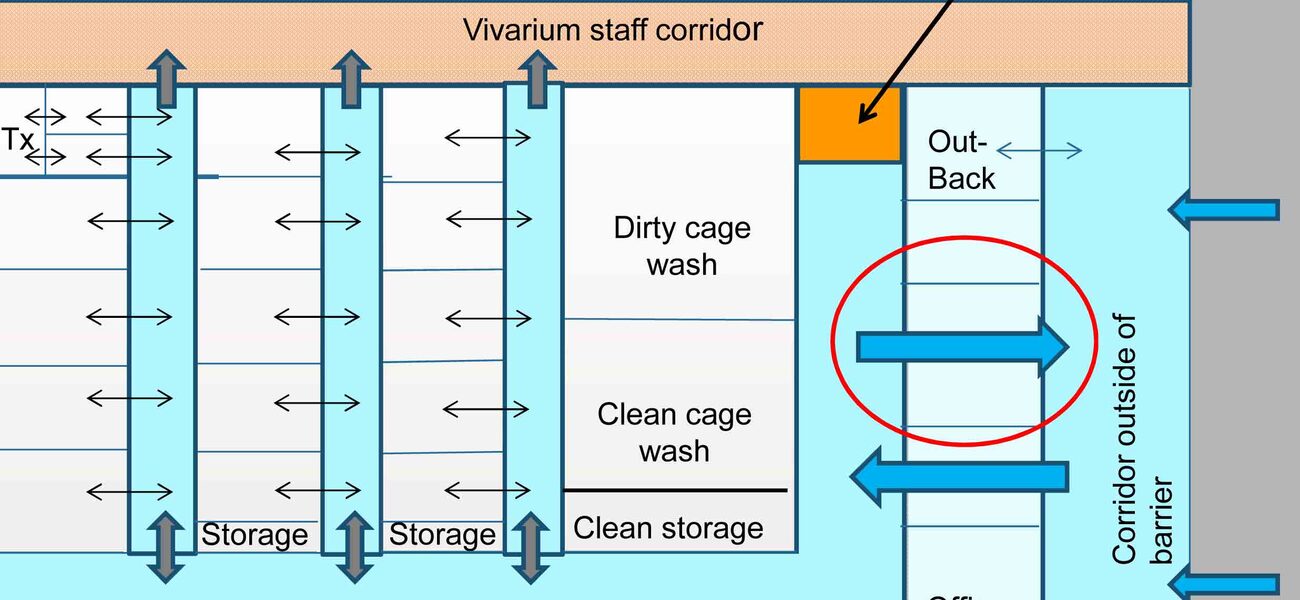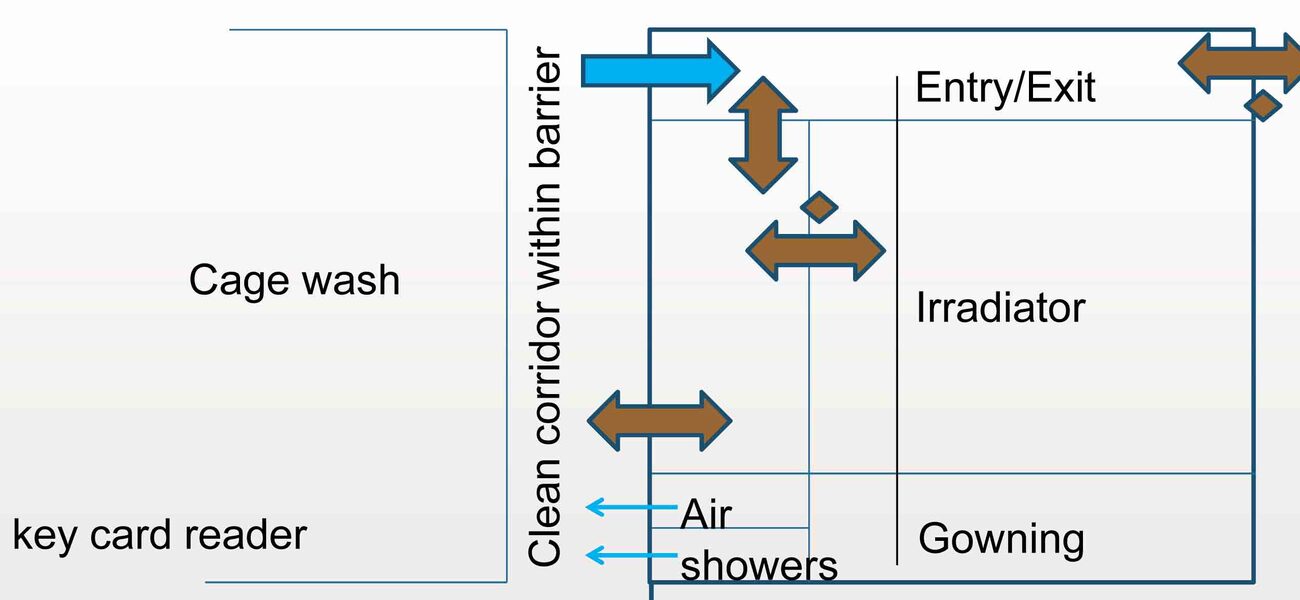A new animal facility at the University of Massachusetts Medical School features more efficient cage handling and cleaning, interstitial catwalks for maintenance, and a dual-corridor layout that minimizes contamination, all of which are best practices for decision-making and design, according to Jerry Silverman, director of the university’s Department of Animal Medicine, and laboratory/animal facility planner Josh Meyer. The Albert Sherman Center, the third such facility to be opened on the campus, contains several of these improvements over its predecessors.
“It’s common in academia for the principal investigators (PIs) to take the animals up to their labs, which presents a contamination risk when they are being brought back,” says Meyer. To reduce this risk, the design incorporates an “out-back” set of cubicles behind a barrier. “Early on, we thought about how people were going to enter and exit, and what personal protective equipment (PPE) they would be wearing,” he says. Staff enter and go into the air showers. They exit the air showers into the barrier area. “There’s a psychological aspect,” says Meyer. “At Harvard, as well as UMass Medical School, they want an air shower because they want everybody to recognize when they are entering a clean area. Having the air shower precludes somebody from piggybacking into the animal facility, so it’s also good security.” Material flow is also extremely straightforward, with soiled racks and cages being queued in the rear corridor.
Going By the Numbers
The number of cages and the number of PIs for the Albert Sherman Center were key factors influencing the configuration of the main space. At a comparable facility that opened in 2001, notes Meyer, an 80 percent “ergonomic capacity” for cage racks was optimal. The Albert Sherman Center has a maximum capacity of 15,000 cages and a practical (ergonomic) capacity of 12,000 cages. “We determined that there would be an average of four PIs per room,” says Meyer.
The species to be studied set the tone for much of the design, as well as for some of the equipment, such as robotics. “I’m not aware of any robotic equipment that can switch from one species to another, such as between mice and rats,” says Silverman. A mice-only population was chosen. “The cutoff is 2,500 cages a day when you might want to go with robotics for cage washing,” says Meyer. “With more than that, you really need another tunnel washer.” Both foundry and gantry-type robots were considered, and the gantry type was selected because of its lower maintenance cost. The foundry robot has seven axes, so is more flexible; the gantry type glides on a track that stops at different places to perform preprogrammed tasks. “There’s no need to pay for more machine than you need,” says Meyer.
Once mice had been chosen, the question of disposable versus reusable cages was examined. Several considerations went into the decision, including the plan to fill the vivarium over a period of five to seven years. The cost of a bedding conveyor for reusable cages versus that of purchasing 1,000 disposable cages at a time was assessed. “With disposable cages, one has to get the cages down to the first floor and store them until a recycling company takes them away,” Silverman says. “That was doable, but it involved more time than if we purchased bulk bedding and used a chain-drag system to bring it up to the second floor. With reusable cages, the dirty bedding just gets dumped into a dumpster.” A second chain-drag system on the second floor handles dirty bedding, pulling it along with a series of hockey-puck-like snags.
“Another big consideration with the disposables versus reusables is the cost of utilities,” Silverman says. “But that was difficult to calculate. We ended up getting an estimate from our facilities maintenance group.” Lastly, they considered cost of labor and equipment, and factors such as maintenance contracts. “We graphed out the cost and found that the disposable cages and reusable cages reached the break-even point after approximately seven years,” he says. “At that point, the disposable cages become more expensive, because every year you are replacing them. So for us, it was a good move to use reusable cages.” He cautions that this solution might not make the most sense for a project with different needs or budgeting. “Some institutions might not want to put out (the money for reusable cages) up front.”
The university then needed to assess which racks made the most sense. “We had experience with the typical caster mouse racks, and we decided to stick with them,” says Silverman. “The ‘turntable’ style racks have a protective bar at the bottom that stuck out too far into the room, so we were losing space on both sides. The wall-mounted racks weren’t an option, because we do quarterly sanitation. It is much more difficult to detach a wall-mounted rack, find a place to put the animals temporarily, wipe down the walls, and then reattach the racks and transfer the animals back.” The single-sided racks are separated by a 6-foot aisle. “In the previous facility, there was a biosafety cabinet for every 2,000 cages of mice,” says Meyer. “In this facility, it is one for every 500 cages. I firmly believe that having a biosafety cabinet for every 400 to 500 cages is the right metric given the number of PIs.” According to Meyer, top schools in the U.S. average approximately 100 and 150 cages per PI.
The final decision was whether to use autoclaves or dry-heat ovens for cage sterilization. “Dry-heat ovens are less expensive to purchase, run, and repair,” says Silverman, “but it takes a couple of hours to do a cycle, whereas an autoclave takes about 40 minutes. However, these ovens are big enough that we could fit four pallets of cages in each one. That’s 320 cages every two hours. A single oven can do 1,200 cages a day. We purchased two of them.”
Planning for Cleanliness, Security, and Research Integrity
The location of the bulk autoclave was strategic. “There are two entrances to the vivarium: the main one and the service elevator,” says Silverman. “People tend to take their dirty cages that are up in the laboratories and bring them down to the washroom, which exposes the clean animal facility to those cages from the laboratories. With the autoclave at the main entrance, you reduce that potential.” The small amount of office space in the facility has a gatekeeping function, with supervisors able to see people who might be trying to enter the rooms without sufficient PPE.
Also strategically located, the cesium irradiator is accessible from two different pathways. In layouts where the irradiator was in the middle of the facility, researchers who wanted to irradiate cells rather than animals did not always properly “gown up.” The new facility places the irradiator between the barrier part of the vivarium and a non-barrier corridor to segregate the different research needs. Those with cells to irradiate can gown up and enter the irradiator from the non-barrier corridor, while those irradiating animals can enter the irradiator room from the barrier corridor. Those with animals remain inside the barrier. “This has been a very effective way of having people with both cells and animals use the same irradiator,” says Silverman.
Smart Interstitial Space
With the amount and frequency of maintenance required by any vivarium, smart interstitial space planning is crucial. The Albert Sherman Center features an innovative system of catwalks over the corridors, from which all serviceable components are accessible. “Compared to a full interstitial that needs 20 to 22 feet floor-to-floor, this can be done in 18,” says Meyer. He urges project planners to choose engineering consultants that have a good grasp of interstitial space, and to look for cost-saving ways to incorporate it. At the largest institutional vivarium in the U.S., Children’s Hospital of Philadelphia, the solution was a “saddlebag” off to the side rather than overhead interstitial space. “The facility is below ground and in solid rock,” says Meyer. “For every foot we could avoid going down, we saved millions of dollars.” The drawback with such an approach, he says, is that the interstitial “saddlebag” may require too much effective floor space.
Preventing Light Pollution
Most animal facilities run a dark cycle during which various research activities often occur, but a growing body of evidence suggests that the short bursts of light from main corridors can disrupt animals’ circadian rhythms. “Originally, we assumed that the fire code demanded white lights in the main corridor,” says Meyer. “When the door to the animal housing room was opened, the corridor lights were supposed to turn red. However, it took two or three seconds to make that switch, which was a big problem.”
Adding a vestibule was not an option for space reasons. Adding a delay to the door was considered to prevent it from opening until the corridor lights had turned red. But the solution was simpler—a quick check with the fire department revealed that, in fact, the corridor lights did not have to be white. At night, the corridor is illuminated by red bulbs. If any heavy work needs to be done at night, white task lighting is employed. “There have been no continuing problems,” says Silverman.
“We all know what to do for animals, but we have two customers: animals and researchers,” says Silverman. “Listen to the researchers, as well as your architects and engineers.” Like Meyer, he counsels careful selection of consultants. “I have been involved in a facility design where they took the lowest bid, which was from an architecture and engineering firm that had never done animal facilities. We had to spend a lot of time educating them,” he says. Meyer agrees, noting that a good animal facilities designer will examine the minutia early in the planning process.
“Compromises may have to be made, but don’t compromise there,” he says. With a solid project team and wise decision-making, the Albert Sherman Center has accomplished its own goals and set practical precedents for animal research elsewhere.”
By Liz Batchelder
This report is based on a presentation Silverman and Meyer gave at Tradeline’s Animal Research Facilities 2014 conference.



